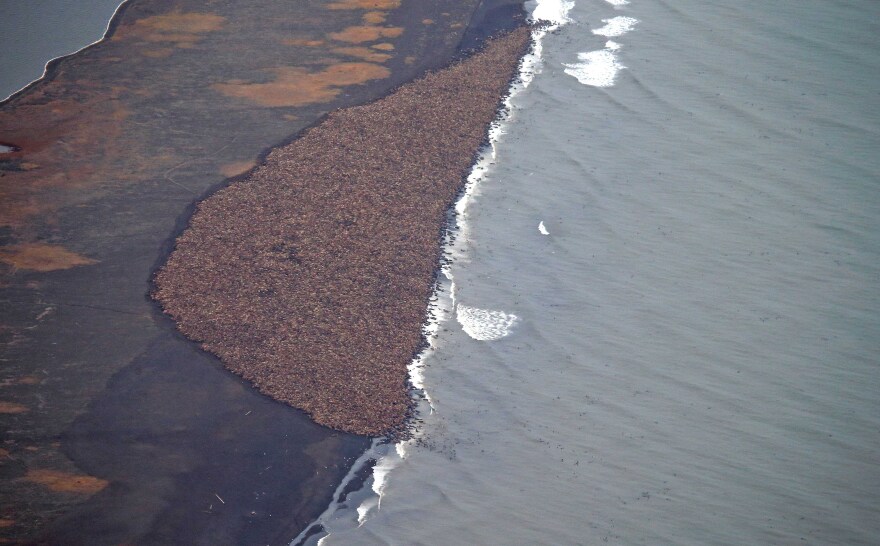Due to shrinking and disappearing sea ice caused by climate change, tens of thousands of Pacific walrus have hauled out on shore near Pt. Lay, a village in Northwest Alaska far from their feeding grounds. During a press teleconference Wednesday (Oct. 1), Joel Garlich Miller, a biologist with the U.S. Fish and Wildlife Service, said the haul-out of 35,000 walrus this time of year in this location is a change from the past.
“Up until 2007 we did not see the regular occurrence of summer haul-out sites along the Alaska coastline in September,” says Garlich Miller. “And we've confirmed this with elders in the communities this new pattern of summer haul-out use is a relatively new phenomenon in our lifetime.”
In times past, walrus ordinarily would be scooping up clams, worms and snails in shallow waters farther north in the Chukchi sea, in an area called Hannah Shoal. Because of the lack of sea ice, they’ve moved to shores in Northwest Alaska and Russia.
Research ecologist Chad Jay heads the U.S. Geological Survey’s walrus research program tracking radio-tagged walrus. He says they’ve learned most of the walrus at Point Lay are feeding in waters some 15 to 20 miles away, waters that aren’t as productive as Hannah Shoal.
“We had one animal that spent two weeks actually traveling when it went the 150 miles up to Hannah Shoal and back again,” says Jay. “There were other animals with a little less than that."
Jay says when sea ice is present the walrus might feed for a day or so then rest for half a day. The longer commute to reach food has changed their schedule.
“The cost to that is that they're now then spend much less time, maybe 10% of their time resting on shore,” says Jay, “when the do that versus maybe 50% of their time when they're able to use sea ice for feeding."
Biologists are monitoring the animals to see how the lack of rest is affecting their health. Garlich Miller says they’re also asking the public to stay away from the massive haul-outs.
“Over the past several years, we've had reports of several thousand walruses perishing along the coastline as a result of disturbances at coastal haul-out sites,” says Garlich Miller."
He says the walrus are easily spooked.
“The stampedes are caused by a variety of things. They can be human activities, gunfire, aircraft overflights,” says Garlich Miller. “Some of them are more natural occurrences. The haul-outs attract predators such as polar bears and grizzly bears, which can harass the animals as well."
Garlich Miller says some of the best and most successful conservation efforts they’ve observed have occurred at the local level.
“The community of Pt. Lay in particular has shown a great stewardship ethic at the haul-out,” says Garlich Miller.
He says villagers are educating and monitoring pilots and visitors, to make sure they don’t spook the animals.
“They work with their tribal members to not to motor by the haul-out with boats. They've changed their hunt patterns. Although they are a subsistence hunting community and legally entitled to hunt walrus,” says Garlich Miller, “they've refrained from hunting at these large haul-outs, where disturbances events can lead to lots of unnecessary mortalities."
The Native Village of Point Lay is declining interviews, hoping to dampen some of the interest they fear will draw tourists to the area. Thursday, their tribal Administrator was assisting biologists examining walrus carcasses, checking body weight and other health indicators.

